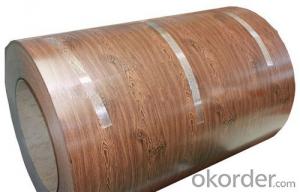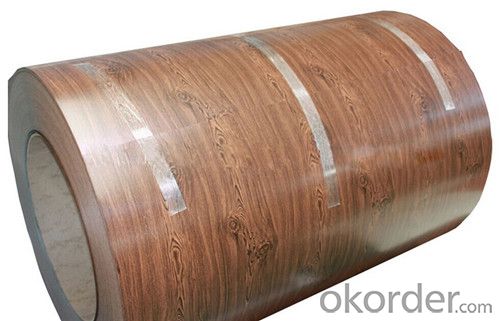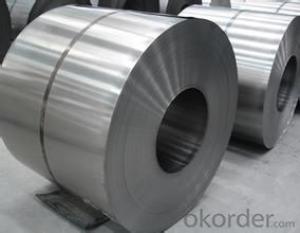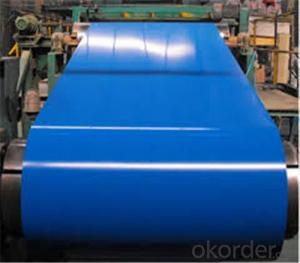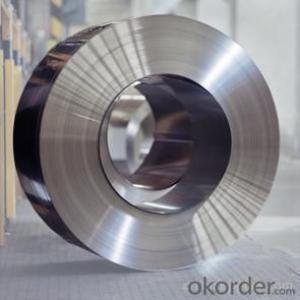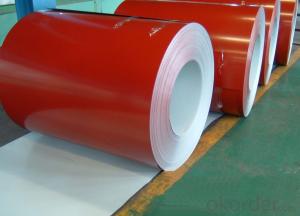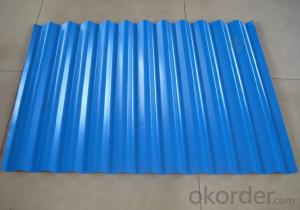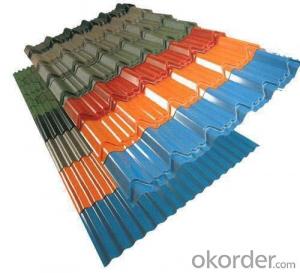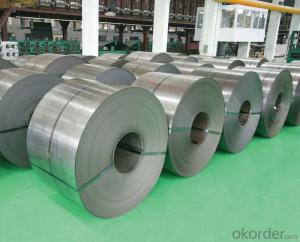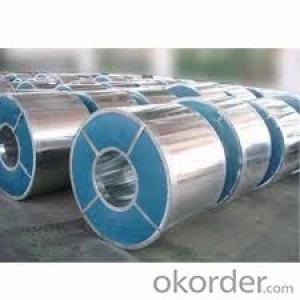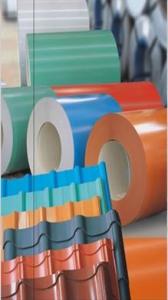Color Coated galvanized Cold Rolled Steel Coil
- Loading Port:
- Tianjin
- Payment Terms:
- TT OR LC
- Min Order Qty:
- 20 m.t.
- Supply Capability:
- 300 m.t./month
OKorder Service Pledge
Quality Product, Order Online Tracking, Timely Delivery
OKorder Financial Service
Credit Rating, Credit Services, Credit Purchasing
You Might Also Like
Prepainted steel coil
Specifications
1.Standard: ASTM,GB,JIS
2.Grade : DX51D+Z
3.Thickness: 0.18-1.5mm
4.Width:914-1250mm
5.Top paint:20mil,Black paint:7mil
6. Technical/Surface treatment: color coated/galvanized/galvalume
7..Useage: widely used in construction,home,appliance,decoration,wear resistant steel,etc.
Advantages:
1. more than 10 years experiences in steel b2usiness
2. good quality
3. competitive price
4. meet your needs via reprocessing
5. excellent service
6. short delivery time
| Commodity : | Prepainted steel coil /PPGI /PPGL |
| Materials Grade: | SGCC ,CGCC ,DX51D+Z ,SGLCC |
| Thickness : | 0.17-1.2mm |
| Width : | 914mm,1219mm,1000mm,1220mm,1250mm ( can cut to strip above 30mm width ) |
| Zinc coating : | 60-275g/sqm |
| Surface Structure: | Galvanized Or Aluzinc |
| Color : | RAL No. or Sample color |
| Painting : | Top : 5micron primer +15-20microns polyester Back : 5-8microns primer epoxy |
| Coil Weight : | 2-6mts |
| Payment term : | TT ,L/C AT SIGHT , USANCE L/C ,D/P |
| Shipment : | 20 feet container or bulk ship |
| Remark : | We accept the third-party inspection ,such as SGS , INSPECTORATE ,CIQ |
- Q: How can the quality of steel coils be ensured?
- The quality of steel coils can be ensured through various measures such as regular testing and inspection, adherence to industry standards and specifications, quality control processes during manufacturing, and certification from reputable third-party organizations. Additionally, proper handling, storage, and transportation practices play a crucial role in maintaining the quality of steel coils.
- Q: In pounds per square inch what is the tensile strength of strong steel?
- I okorder /
- Q: How are steel coils inspected for weldability using welding tests?
- Steel coils can be inspected for weldability using a variety of welding tests. One common method is the bend test, where a section of the coil is cut and bent to evaluate the quality of the weld. This test helps determine if the weld is brittle or contains any defects that could compromise its integrity. Additionally, the guided bend test is performed to assess the ability of the weld to withstand bending without cracking or breaking. Another technique used is the macro etch test, where a sample is prepared by cutting a cross-section of the coil and then etching it with a chemical solution. This test helps reveal any imperfections or inconsistencies in the weld, such as porosity, slag inclusions, or lack of fusion. Furthermore, the hardness test is conducted to measure the hardness of the weld. This is important as excessive hardness can lead to cracking or brittleness, while insufficient hardness may result in weld failure under certain conditions. Additionally, non-destructive testing methods like ultrasonic testing, magnetic particle inspection, or radiographic examination can also be employed to detect any internal defects, such as cracks or voids, in the steel coil welds without damaging the material. These welding tests are crucial in ensuring the quality and weldability of steel coils before they are used in various applications. By conducting thorough inspections, any potential issues can be identified and addressed, ensuring that the steel coils meet the required standards for weldability and structural integrity.
- Q: Can steel coils be customized in terms of size and thickness?
- Yes, steel coils can be customized in terms of size and thickness. Steel manufacturers have the capability to produce coils in various sizes and thicknesses to meet the specific requirements of customers. This allows for flexibility in applications and ensures that the steel coils can be tailored to suit different industries and projects.
- Q: How are steel coils used in the manufacturing of roofing materials?
- Steel coils are used in the manufacturing of roofing materials as they are rolled into sheets or formed into various shapes to create durable and long-lasting roofing products. The coils are processed through machines that cut, bend, and shape them into the desired dimensions and profiles required for different types of roofs.
- Q: How do steel coils contribute to the aerospace industry?
- Steel coils contribute to the aerospace industry by being used in the manufacturing of various aircraft components such as engine parts, landing gear, and structural elements. The high strength and durability of steel make it a preferred material for these applications, ensuring the safety and reliability of aircraft. Additionally, steel coils are also used in the production of specialized tools and equipment required for aerospace manufacturing processes.
- Q: Can steel coils be custom-made to specific requirements?
- Yes, steel coils can be custom-made to specific requirements. Steel manufacturers have the capabilities to produce steel coils with various dimensions, thicknesses, and specifications to meet the specific needs of customers. These coils can be customized in terms of width, length, weight, and even surface finish to suit specific applications and industries. Customization can also include variations in steel grade, coating type, and mechanical properties to ensure the desired performance and functionality. The ability to tailor steel coils to specific requirements allows for optimal utilization in various sectors such as automotive, construction, appliances, and manufacturing, among others.
- Q: What are the different methods of coil edge trimming?
- There are several methods of coil edge trimming, including shearing, slitting, and laser cutting. Shearing involves cutting the edges of the coil using a large blade or shear. Slitting involves making multiple cuts along the coil's edges using a slitting machine equipped with circular blades. Laser cutting uses a high-powered laser beam to precisely cut the coil's edges. Each method has its own advantages and is chosen based on factors such as the material being trimmed and the desired precision of the cut.
- Q: I've been looking into battle-ready katanas a lot lately. And I've come across some debates between the best forges and steels to be used for them. The functional katanas I use now are Musashi brand katanas, using 1045 carbon steel. They each cost roughly $200-$250. The straight carbon steels are mentioned in the debates, but they aren't very sophisticated in their design. Now the higher end of this middle class of katana ($250-$1000) uses higher carbon. spring, damascus, and other various steels and combinations. I've heard a lot about the strength of damascus steel and it's cutting power. But I look for more than that. I've also been looking at (and for) durability, flexibility, and how well it stands up to contact. So I guess what I'm asking is for the opinion of people who have used these steels, and an answer on what the community thinks is the best steel for a mid range ($250-$1000) battle-ready katana. Looking forward to some good answers.
- There is no such thing as a battle ready katana... if it is not ready for battle - it is not a katana. Having said that: The hardness of the cutting edge depends on the carbon content the better (in general). 1045 is poor quality steel for sword manufacture. Musashi swords are cheap pieces of crap. 1060 is better. Some manufacturers use modern materials that aren't perhaps consistent with traditional manufacture, like 9260 silicon spring steel or even L6 Bainite. Damascus steel is not a type of steel at all. It is a folding technique that creates a wavy grain in the metal. It may or may not mean that a sword is good. No swords will stand up to contact with other swords. They will inevitably be damaged. The best way to find a quality sword is to ask you instructor. There are no quality swords under a thousand dollars. The answer also depends on what you are going to do with the sword. It may also depend on the style or school of swordsmanship.
- Q: How are steel coils inspected for surface defects using non-destructive testing methods?
- To ensure the quality and integrity of steel coils, non-destructive testing (NDT) methods are employed to inspect them for surface defects. Several common NDT methods are utilized in this process. Visual inspection is one of the most widely used methods, where trained inspectors visually examine the steel coils for visible defects like scratches, cracks, pits, or corrosion. Although this method is simple and cost-effective, it can only detect surface-level defects. Magnetic particle testing (MT) is another commonly used NDT method. It utilizes magnetism to identify surface and near-surface defects in ferromagnetic materials like steel. By applying a magnetic field and iron particles to the steel coil, any defects such as cracks or discontinuities become visible as the iron particles concentrate around them. Liquid penetrant testing (PT) is a different NDT method used for inspecting steel coils. It involves applying a liquid penetrant to the coil's surface, which is drawn into surface defects through capillary action. After removing excess penetrant and applying a developer, the defects become visible as the developer draws out the penetrant. Ultrasonic testing (UT) is widely used to detect both surface and subsurface defects in steel coils. It transmits high-frequency sound waves into the coil and analyzes the reflected waves to identify abnormalities. This method can detect defects like cracks, inclusions, and voids that may not be visible to the naked eye. Additionally, eddy current testing (ECT) is another NDT method for inspecting steel coils. It utilizes electromagnetic induction to detect surface and near-surface defects. By placing a coil carrying an alternating current near the surface of the coil being inspected, any changes in the coil's electrical conductivity caused by surface defects are detected and analyzed to identify and evaluate their severity. In summary, various non-destructive testing methods such as visual inspection, magnetic particle testing, liquid penetrant testing, ultrasonic testing, and eddy current testing are utilized to inspect steel coils for surface defects. These methods ensure the quality and integrity of the steel coils before they are used in various applications.
Send your message to us
Color Coated galvanized Cold Rolled Steel Coil
- Loading Port:
- Tianjin
- Payment Terms:
- TT OR LC
- Min Order Qty:
- 20 m.t.
- Supply Capability:
- 300 m.t./month
OKorder Service Pledge
Quality Product, Order Online Tracking, Timely Delivery
OKorder Financial Service
Credit Rating, Credit Services, Credit Purchasing
Similar products
Hot products
Hot Searches
Related keywords
